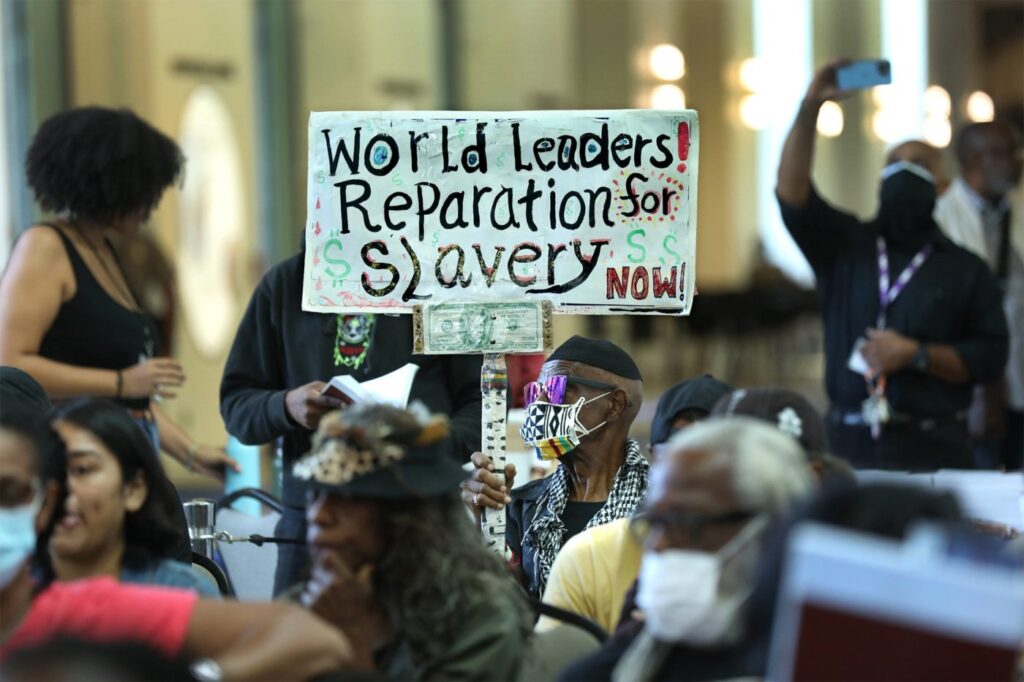
California’s three-year-old Reparations Task Force might have been much better off had it taken a week or so after the latest U.S. Supreme Court ruling on affirmative action before revealing its plan for monetary and other compensation to the descendants of African-American slaves.
For the court’s 6-3 decision ending affirmative action in college admissions (and likely in many other areas, too) makes it very plain that if California lawmakers actually adopt many of the task force’s 100-plus recommendations, they will quickly be struck down in courts that abide by decisions of the nation’s highest judicial body.
That’s because receiving benefits from the task force’s suggestions – and that’s all they really are – would depend mostly on ancestry and race rather than anything that has happened to any living individual.
That’s a complete no-no, wrote Chief Justice John Roberts in the Supreme Court’s governing opinion eliminating race-based affirmative action at Harvard University and the University of North Carolina, which served as stand-ins for all the other institutions that have practiced affirmative action for decades.
Meanwhile, the justices essentially upheld what California universities and some employers did after this state banned affirmative action via a 1996 ballot initiative.
Roberts wrote that if individuals have demonstrably overcome handicaps, overt racial or religious bias, poverty and other serious roadblocks to success, it’s fine to give them special consideration in college admissions. But race or ancestry by itself is no longer enough to merit such treatment.
That’s essentially what California universities have done since the late 1900s. The results have created student bodies not quite as diverse as before, but still allow for a very robust mix of races and ethnicities at this state’s colleges. Essentially, the California campus’ route around the end of affirmative action has been endorsed for use nationwide.
The same thing should happen with the Reparations Task Force recommendations, which provide formulae for the state to award billions of dollars worth of grants to the descendants of former slaves. They would be compensated not only for slavery, but also for post-slavery discrimination including injustices perpetrated by courts, health care systems, universities, real estate agents, red-lining banks, apartment landlords and employers, among others.
The task force recommends a blanket apology for treatment of African-American slaves, former slaves and their descendants in California, even though it was never formally a slave state. The group said nothing about other forms of slavery practiced here for many decades, including forced labor by Native Americans whose settlements were often destroyed, similar forced labor by imported Chinese workers and some other human trafficking offenses.
There is no mention of the fact that California fought to end slavery in the Civil War, although prior to that, slave owners could and sometimes did bring enslaved individuals here with them. The state’s African-American slave population rarely exceeded 10,000.
But the distinguishing fact about the task force recommendations is that they hinge almost entirely on ancestry – only direct descendants of African-American slaves need apply for any benefits if a procedure is ever established.
That runs directly contrary to the Supreme Court’s logic in striking down affirmative action. So it probably won’t fly in any court where a lawsuit might be filed against the restitution plan or any materially significant part of it that state lawmakers might someday pass.
Related Articles
Douglas Schoen: Chris Christie may lose the battle but win the war against Donald Trump
A post-clemency prosecution shines a light on a broken system
Judge Andrew Napolitano: Democracy without safeguards and constraints is a threat to liberty
Should California’s coast be affordable too?
Creating a new ‘right’ is the wrong way to fix California’s housing crisis
Of course, that does not rule out an official apology from the state for whatever role California played in sustaining or encouraging slavery. Nor would it rule out special grants to schools that serve predominantly minority student bodies. Such grants exist today.
Nor does it negate the recommendation that the state Department of Justice lead an effort to root out racial bias in courts and prisons. It also does not prevent carrying out the recommendation for “listening sessions” about racial injustices, collecting personal testimonies for historic preservation and use of school curricula to help end racism.
None of those things provide direct material benefits to any individual, even if they could lead to major improvements in the lives of many who believe they suffer discrimination today.
But direct financial benefits to individuals based on this plan are unlikely to materialize, despite the strong sense among many African-Americans that this would be yet another injustice against them.
Tom Elias’ email address is tdelias@aol.com
